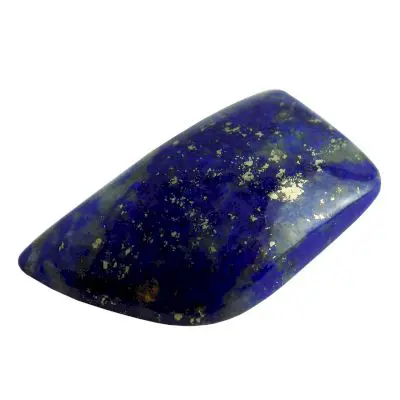Glazed brick panel with Aurochs - details of the Babylonian Ishtar Tor (Ishtar Gate) in the Istanbul Archeology Museum on October 30, 2015, in Istanbul, TurkeyIn the tenth century, which includes the last period of writing this article, Bayhaqi and Mohammad Ibn Mansour mentioned four mines in the Kashani style in mentioning the azure mines

Lapis lazuli has been referenced in ancient Mesopotamian texts, such as the Epic of Gilgamesh, one of the oldest known literary works. The blue Stone was associated with royalty and divinity, symbolizing power, protection, and wisdom. Lapis lazuli held great value in ancient Egyptian civilization. It was considered a precious stone and was highly favored for Jewelry and decorative objects. The Egyptians associated Lapis lazuli with the heavens and used it to depict the night sky in their artwork. The stone was also believed to have protective and healing properties.
While Lapis lazuli is not specifically mentioned in the Qur'an, it is referenced indirectly in descriptions of Paradise (Jannah). In Islamic literature and hadith (sayings and actions of Prophet Muhammad), descriptions of the splendor and beauty of Paradise often include references to precious gemstones, including Lapis lazuli. These descriptions highlight the magnificence and rewards that await the righteous in the afterlife.
Azure has been widely used in Islamic art and architecture. It can be found in intricate calligraphy, Manuscript illumination, mosaics, and tile work in mosques, palaces, and other Islamic structures. The vibrant blue color of Lapis lazuli adds a sense of richness and elegance to these artistic creations, symbolizing the divine and spiritual realms.
Lapis lazuli is mentioned in Islamic literature and holds significance in Islamic traditions. In the Islamic tradition, Lapis lazuli is referred to as "Yaqut," and it is associated with various symbolic meanings. It is believed to represent truth, sincerity, and the heavens. The stone is also mentioned in the description of Paradise (Jannah), where it is said to be used in the construction of palaces and structures for the righteous.
Azure is mentioned in historical texts, including travelogues and accounts of explorers and merchants. For instance, the famous Moroccan scholar and traveler Ibn Battuta, who extensively documented his travels across the Islamic world in the 14th century, mentioned Lapis lazuli in his writings. He described seeing Lapis lazuli being used in architecture and Decorative arts during his visits to various regions.
Scientists have so far identified several mines for lapis lazuli, but only a few by lithological experiments approved. Abu Rihan al-Biruni writes in the valuable book Al-Jamahir Fi Al-Ma'rifah Al-Jawahir: He also says: « Azure is called Arminaton in Rome». This book is the oldest work that mentions the existence of Lajevardi mine other than Badakhshan mine. In the book of geography related to the sixth century AH. AH, Only the existence of lapis lazuli mine in the mountains of " Sabar Maq " in Khorasan is mentioned.
While the science of archeology and geology of the two mines of Badakhshan (in the fourth and third millennia BC and Quetta are called, Islamic texts associated with Azure mine in northwest Iran was confirmed. In the eighth century, Ibn Battuta and Amoli only mentioned the Lapis Lazuli mine in Badakhshan. In the same century, in the book of Iraq Al-Jawahir in Al-Nafis Al-Atayb, for the first time, four types of azure, Badakhshan, Kermani, Georgian, and Desmari are mentioned.
Glazed Brick panel with Aurochs - details of the Babylonian Ishtar Tor (Ishtar Gate) in the Istanbul Archeology Museum on October 30, 2015, in Istanbul, Turkey. In the tenth century, which includes the last period of writing this article, Bayhaqi and Mohammad Ibn Mansour mentioned four mines in the Kashani style in mentioning the azure mines. With the difference that instead of the Georgian mine, they call it the Karaji mine. Beyhaqi states this in determining the location of Karaj.
Lapis lazuli has been associated with various metaphysical properties in Islamic traditions and other belief systems. It is believed to have healing properties and is considered beneficial for mental clarity, spiritual growth, and protection against negative energies. Some Islamic scholars and practitioners of traditional medicine have recommended the use of Lapis lazuli for its potential therapeutic benefits.
Azure has been a valuable commodity in the ancient world, and its trade routes and networks played an important role in connecting different civilizations. In Islamic history, merchants and explorers traveling along the Silk Road and other trade routes would encounter Lapis lazuli as it was traded between different regions, including Afghanistan, Iran, Central Asia, and the Mediterranean. Its significance in trade and commerce contributed to its cultural importance.
Lapis lazuli carries symbolic meanings in Islamic culture. It is associated with virtues such as integrity, sincerity, and truthfulness. The stone's deep blue color is often seen as a representation of the heavens and the eternal truths of Islam. It has been used as a symbol of spiritual enlightenment and a reminder of the divine.





